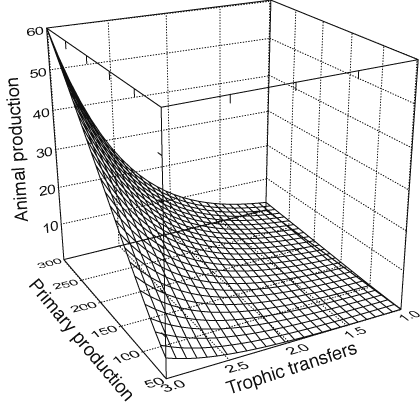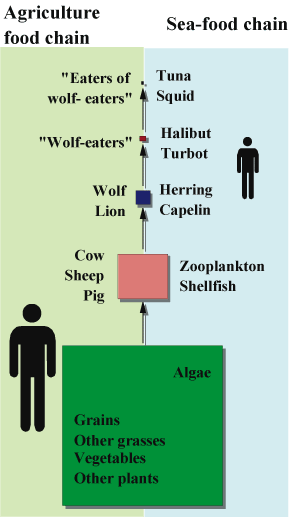


 |  |  | 15.1 Background |
The global human population is expected to reach about 10 billion by 2050, and it can be questioned how humans will be able to provide the food needed to feed that population. A sustainable development of the agricultural sector is in all events needed, but the potential of the marine sector for increased contribution is now frequently addressed. An increase in agriculture will require considerable investments in research, wider implementation of intensive agricultural technology, use of genetically improved plants and animals, more efficient distribution of produced food, availability of sufficient freshwater, and a significant increase in new agricultural land. These preconditions call for a precautionary approach; we will need to search for options for food production also outside the agricultural sector. More seafood and food production based on biotechnological methods are among the most obvious options available. Seafood contains essential lipids and is therefore greatly demanded from nutritional and health perspectives (see e.g. Sinclair and Gibson [422]). The available and prospected bioprotein sources cannot so far replace food of aquatic origin here. Marine fats contain n-3 fatty acids that are essential for humans, and a suboptimal supply may affect the quality of life, because it results in a higher frequency of heart and coronary diseases and in some extreme cases mental health problems, such as deficiencies [338][197].
A main motivation for strengthening of the marine sector is the fact that only a very low proportion of human food originates from the ocean. FAO statistics (www.fao.org) show that only about 1 and 5% of human energy and protein consumption, respectively, originates from the fisheries and aquaculture. This is surprising because marine and terrestrial primary production is of the same magnitude, and it implies that the traditional mode of harvesting the marine ecosystem is less efficient than our cultivation and harvesting of the terrestrial ecosystem. It is well known that the production of the world's oceans is temporarily and spatially very patchy. The classic analysis of Ryther [401] suggested that some coastal upwelling areas are highly productive, whereas the majority of the open ocean is highly oligotrophic, often named marine deserts. The coastal marine systems are normally intermediate. The theoretical analysis of Ryther [401] suggested that 50% of the global fish and squid production took place in the major coastal upwelling systems of the Earth which constitute only 0.1% of the ocean surface. The next 50% of the production potential was located in the 10% which are coastal waters, whereas the 90% surface which was defined as open ocean, was responsible for <1% of the production. The numbers for upwelling systems cannot be directly evaluated based on fishery statistics -- because fish migrate. Even though they are most likely overestimates, they are still representative. An ultimate question is if such high-productive marine ecosystems can be artificially created by some means. This, together with the general low harvesting yields compared to the marine primary production, illustrates a potential call for research to increase the marine food supply for human consumption.

A very simple comparative analysis of production and harvesting strategies in agriculture and fisheries/aquaculture clearly indicates why a major fraction of the food is produced in agriculture. The analysis is based on the simplest principle of food web energetics and empirical knowledge on agriculture and marine food web structures.
Figure 1 illustrates the principal relationship between secondary production potential (stocks which are harvested) as a function of the primary production and the number of trophic transfers of energy (based on Ryther [401]). The upper right corner of the figure is representative for the production conditions of coastal upwelling systems, whereas the lower left corner represents the open ocean. The coastal ocean is intermediate, with a primary production of 100 gC m-2 yr-1 and approximately 2 trophic transfers. The figure shows that:
The secondary production yield is accordingly more sensitive to variations in the number of trophic transfers than to variation in the primary production. Contrary, as much as 80-90% of the assimilated energy is lost each time something eats something else, or for each trophic transfer of the energy. The total range of variability in secondary production caused by the total variability in primary production (Figure 1) is comparable to the variability caused by one single trophic transfer. The figure clearly shows that the high harvesting potential of the upwelling systems is primarily an effect of the short food webs. The physical dynamics of upwelling systems are complex and characterized by high natural nutrient supply from deep water and short food webs, which implies few trophic transfers of the assimilated energy and harvesting on lower trophic levels than in other marine ecosystems.
The above conceptual analysis is simple, and therefore also robust to variability in coefficients and empirical input data. Trophic dynamical models are in fact included in most textbooks on ecology. The above conceptual relationships, which are laws of nature, are however not very frequently considered in evaluations of marine productivity and mariculture potential. It may be questioned if our comprehension fails to fully realize the implications of an exponential loss of energy as we move up the food web.

The above considerations explain the marginal contribution of the marine food web in human food supply (1-2% in 1997, www.fao.org). Figure 2 illustrates human feeding habits for the products from seafood and agriculture, or the human trophic position for these types of food. In the agricultural food web, humans primarily feed on the primary producers, but also on herbivore animals. Food items from higher trophic levels are well known in many cultures, but such food does not contribute significantly to the global food supply. Accordingly, it may be deduced that we feed between trophic level 1 (plants) and 2 (herbivore animals) in the agricultural food web (herbivore-omnivore), which means 0-1 trophic transfers, closer to 0 than 1 because we eat more plants than meat (see Figures 1 and 2).
The situation is quite different for seafood. Humans consume some macroalgae and some animals that feed on algae (e.g., mussels and sardines in upwelling systems). 1st carnivore stocks (animals eating herbivore animals, e.g. zooplankton) and species even higher in the food web are the most important commercial resources harvested from the ocean. A significant fraction of the first carnivore stocks is only used indirectly for human consumption, as they are refined through marine aquaculture or agriculture. The overall result is that we most likely feed between levels 3 and 4 (1st and 2nd carnivores) in the marine food web, meaning that the primary production have passed 2-3 trophic transfers before human consumption.
The above considerations are again oversimplifications, but still relatively robust.
 |  |  | 15.1 Background |